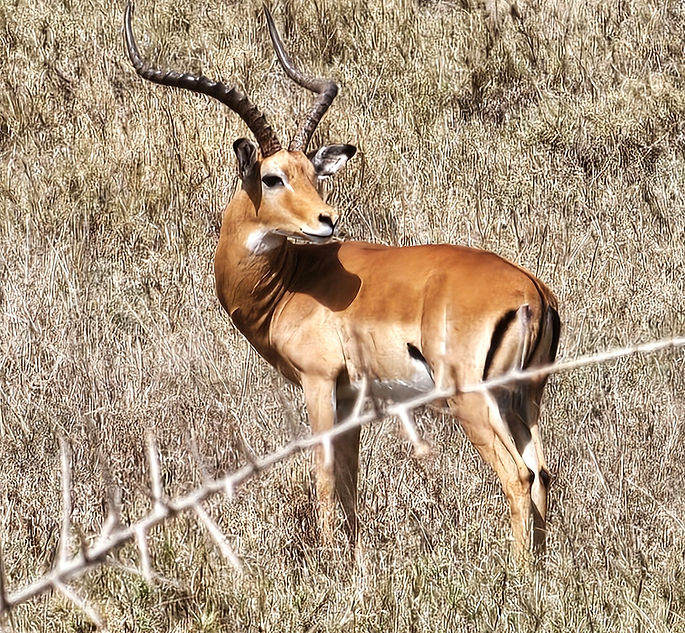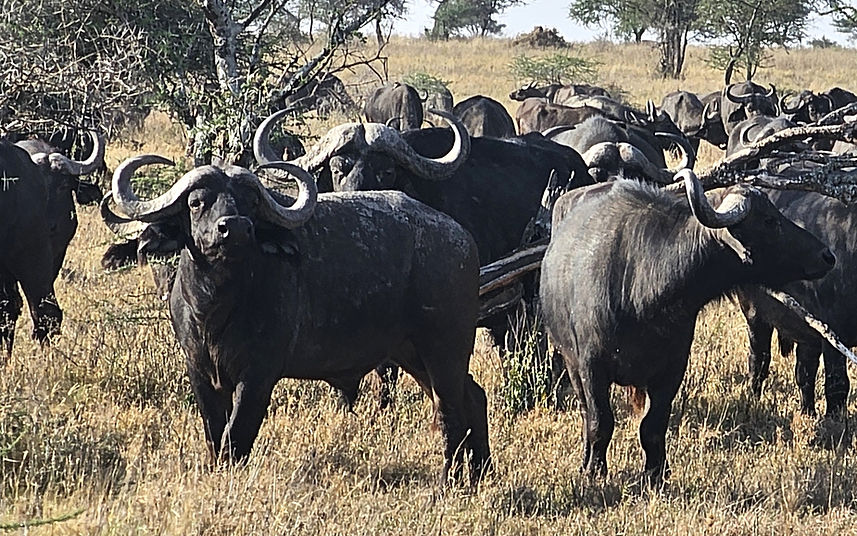
On the Road
with Doug
Leaving August 31 we return from Africa on September 16, 2025.
We will be exploring Kenya and Tanzania on safari.
First stop is the Ol Donyo Lodge.
Tucked in south central Kenya between Tsavo and Amboseli National Parks.
This lodge offers the height of luxury.

Ol Donyo Lodge
This very exclusive property has eight suites. Each suite has an expansive view deck, private plunge pool, indoor and outdoor showers, and night sleep/view deck. All meals are custom prepared and the staff are very warm and engaging.


Plunge Pool
We never used the plunge pool. Safari days are extremely full. Up each day at 5:30 am, we are in the jeep by 6:30 after breakfast. Safari drives are the core of the safari experience and last 4 to 5 hours in the morning followed by a late afternoon drive for about 4 hours.


Oryx

Deck View
Our view deck kept us informed of the goings on down at the waterhole.


Belly-full Cheetah
This cat could not be bothered by a jeep with gawkers. 'Tis nap time.
I know the feeling...
Fat Cat Dining
The lodge's kitchen staff is broadly complemented from Head Chef to Pastry Chef. Every meal is a work of art in addition to being delicious.
The next image is the menu for this lunch.



Super Tusker
This is an elder male. Note his very large, long tusk.
Tusks are necessary tools in an elephants life - used in combat but more regularly to feed.
Eastern Africans are very serious about controlling/combating ivory poachers

Red-billed Hornbill

For our three days at Ol Donyo, Dan was our guide and driver.
He has a huge fund of knowledge. A Maasai warrior, he shared the nature of Maasai life. I am hugely impressed with the way the Maasai solve their problems and the nature of an enduring life in the Modern world. If the world lived in the Maasai way there would be no war and all would be fed.
Our guide is also the driver. Our days are exclusive - the three of us exploring.
The vehicles are rugged Toyota Land Cruisers. There are no formal roads and certainly no pavement. See, go, hang-on.! It is a big upper body workout to keep from bouncing out of the vehicle.


Cori Bustard
Of all the birds in bird-land, this bird weighs the most and is capable of flying.
At the end of the day's drive, folks from the lodge drive out to a predetermined site and only our guide knows its location. Then we drive up to a laid out happy hour with pupus and wine (for Sharon) and Scotch (for Doug).


The baboons were very thirsty. Being very still within our lodge allowed us to watch their dynamic.
The vast plains of eastern Africa are great grasslands. Now in the dry season, the grass is straw dry. Still it is dense and we use all of our faculties to search for what is hidden.
Many eyes are also on us.


The only succulents I saw were euphorbias. Euphorbiaceae are Old World succulents evolved from Madagascar. They have no genetic relationship to the Cactaceae which are new world succulents. Thus the curious nature of convergent evolution.
On this two week trip we went to five different lodges starting in Nairobi and spanning from Kenya north of the Equator to the eastern Serengeti of Tanzania and finally exiting through Dar es Salaam (the capital of Tanzania). This was accomplished by hours of light aircraft shuttles,


Mt. Kenya
This is the second highest peak in Kenya (after Kilimanjaro). It has snow most of the year and that melt supplies water to the surrounding areas. It is the reliable water source for an otherwise parched terrain.
We are now in northen Kenya just above the Equator. Our domicile camp is the Elewana Kifaru House in the Lewa Conservancy. This luxury camp has five cottages.
Sharon is becoming an ever more skilled birder. She is bird-nuts. I think her bird count for this trip is 108 species.
This is a White-browed Coucal.

The Lewa Conservancy is an actively managed conservation area (65,000 acres) with a primary interest in protecting black rhino and Grevy’s zebra. In addition to these two target species it is also home to every other African animal and over 490 species of bird.
Lewa has combined the techniques of world-class anti-poaching operations, including cutting edge monitoring technology, with the engagement of the surrounding communities as critical partners in conservation.


The ”black” and “white” rhinos are the same color. The English word “white” was mistranslated from the original rhino name “wijd” in Dutch. So the wijd rhinos came to be called “white”. White rhinos have wide lower lips (to graze grass) while the black rhinos have hooked upper lips (to strip leaves). Never found it possible to get “dentally” close to a rhino.
Bush Breakfast
This morning we hit the “trail” before sunrise and before breakfast. Two hours later the lodge staff set up a sit-down breakfast out in the bush. Under a wonderful canopy of acacias with sit-down service we had fresh on-site eggs benedict and mimosas.


Fever Trees
These are Yellow-Acacias. They came to be known as “fever trees” by early explorers. They would sleep under their cool umbrella only to later develop and then die from “yellow fever”. They thought the trees were to blame not realizing it was the mosquitoes who live within the trees.
Greve Zebra
The Greve ranges north of the Equator. What distinguishes it are the very narrow stripes. It is endangered.


Reticulated Giraffe
This too ranges in the north. Its coat pattern is reticulated (think like shattered glass). Compare this to the southern giraffe seen earlier.
Dik-dik
These are the smallest of the antelopes. They appear to be the size of a large jack rabbit.


Tawny Eagle

Red Agama


Godfrey
At Lewa, Godfrey was our guide and driver. As typical, we spent hours with him over three days. He has a superb fund of local knowledge. Actively engaging, he too became a real friend. He is dressed in the traditional garb of a Maasai warrior.

Nicholas
Nicholas was our camp manager making sure all of our needs were met from knowing what we liked for cocktail hour, serving us meals, and generally always present and engaged (a personal butler). We became fast friends. Even now across continents we share e-mail correspondence. He is Bantu (not Maasai).

The pastry chef made a delicious birthday cake presented at the end of our evening meal. What was so special was the entire camp staff came out to wish me a Maasai birthday. Lined up like a conga-line they danced in a single file circle around our table, singing, dancing, round and round and round and round. Obviously they enjoyed being together and joyously acting out. One of my life’s highlights.


Pygmy Falcon
Crowned Lap-wing
This member of the plover family is very commonly seen. Flushed out by our passing jeep they are the most ardent squawkers.


Elephants can de-forest vast expanses of foliage. They eat 22 hours a day. They particularly like the bark of acacia trees. Using their tusks they strip off sections of bark. The trees that survive develop "scar" and look like this.
Green Woodhoopoe
These brilliant birds are very social.
They roost in natural cavities - particularly trees


Maasai Mara
We flew from Kenya north of the Equator (Lewa) to the Maasai Mara in the southeast of Kenya just above the border with Tanzania for our third safari stop of the journey. This area just above the Serengeti is the site of the annual migration. The geography here is a meld of rolling savannah, hills, and forests.
Bushtops
Bustops is our domicile here.
It has all the luxurious features we have come to expect.


There are thousands of wildebeests. While they may not be beauties – predators lick their chops.
Typical of safari game lodges is their unobtrusive integration into the landscape.


Our guide knew where to be and when. Young male lions (brothers) were rousing from a lazy afternoon of napping. We were there when they emerged from the bush.

This is my safari “MGM” image.!

Sunset …
Happy hour is just next at hand…
View from the plane...
After two days in the Maasai Mara we flew south into the eastern Serengeti.


Lemala Nanyukie
It was a bone crushing 1 ½ hour drive from the Seronera Airstrip to our fourth safari lodge. Great staff, great accommodations, and terrific food.



Elephants being
elephants – eating.
Verreaux’s Eagle Owl
This largest owl in Africa has pink eyelids. When it flew away its wingspan appeared to be five feet. It has the record for being 4th in the world of owls: Longest life and length and weight.


Hippo
This is the #1 killer of humans in Africa.

Little Bee Eater


Cape Buffalo -This is a really big beast. It is the #2 killer of humans in Africa.

Hyena


Legendary Lodge
We have started the transition back home. Flying from the Serengeti we overnighted in
Arusha at the ultra-deluxe Legendary Lodge (formerly and still within an active coffee plantation). Wow.! Paved roads and manicured grounds!
After an overnight, we fly Arusha to Dar es Salaam, Tanzania (via Zanzibar) and then KLM nonstop to Amsterdam; transferring from Amsterdam via a nonstop to San Diego.

East Africa
Ten time zones away. Twenty two hours of transcontinental air flight.
After our third African safari we feel that we “know” southern Africa (South Africa, Namibia, Botswana, quickies into Zambia and Zimbabwe; Kenya, Tanzania).
The people of eastern Africa are wonderful; exemplary. Though dominated by animals, not humans, it is my memories of the Maasai that have left the deepest mark.
Peace and love for all of us.